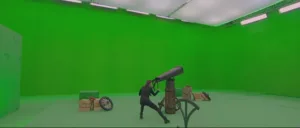The integration of video into a game engine to deliver new VR, AR, MR and green screen broadcast content is an exciting area of development, but one where many new technologies and skill sets will be needed. At NAB, the Unreal team detailed some advances.
On the broadcast side, Zero Density was at NAB to describe their photo-realistic virtual studio solution, powered by Unreal Engine 4, called Reality 2.0. It is designed to help create realistic composites in green screen productions. Key features include:
- Unreal Engine 4.15.1 support
- Full HDR Rendering Pipeline
- Reality now renders multiple 3D passes (such as shadow, ambient occlusion, reflections, bloom and lens flares) and composites these passes over the incoming video image,
- 4:4:4 RGB video I/O
- SMPTE 2084 HDR Video I/O
- Rec 2020 Colorspace
- Support for HDR video sources like Canon Log and Arri Log
- Quadro P6000 (required for UHD resolution) Support for GPUDirect Video I/O,
- Nodegraph processing performance improvements
- Reality Keyer 3D Mask options in addition to the Garbage Mask. ( Force Fill Mask & Spill Bypass Mask)
- Ring buffered & genlocked Video I/O
- User-defined material and blueprint nodes
The Future Group (Oslo, Norway), a pioneer of Interactive Mixed Reality (IMR) content and tools, announced a licensing agreement with Epic Games to use the Unreal Engine 4. The Future Group has built unique enhancements specific to broadcast TV on top of Unreal Engine, including source code-level changes that are claimed to enable feature film-quality 3D rendered scenes created with Unreal for use at broadcast TV resolutions. These technologies provide the ability to merge people and objects in real time into virtual worlds with precise timecode-level accuracy, creating true Interactive Mixed Reality.
The Future Group recently emerged from stealth mode. Its new product is Frontier, a highly-scalable 3D visual effects platform first being used by FremantleMedia (London) in their upcoming IMR game show for worldwide primetime TV, “Lost in Time”. Frontier is co-developed by The Future Group and Ross Video.

Using Frontier powered by Unreal, the company said that any TV production can now create live photorealistic effects and virtual sets that are integrated with anything or anyone from the real world to create IMR-enhanced shows, mobile games and more.
A video showcasing the power of Frontier and Unreal may be viewed at https://vimeo.com/207094054. Password: future

